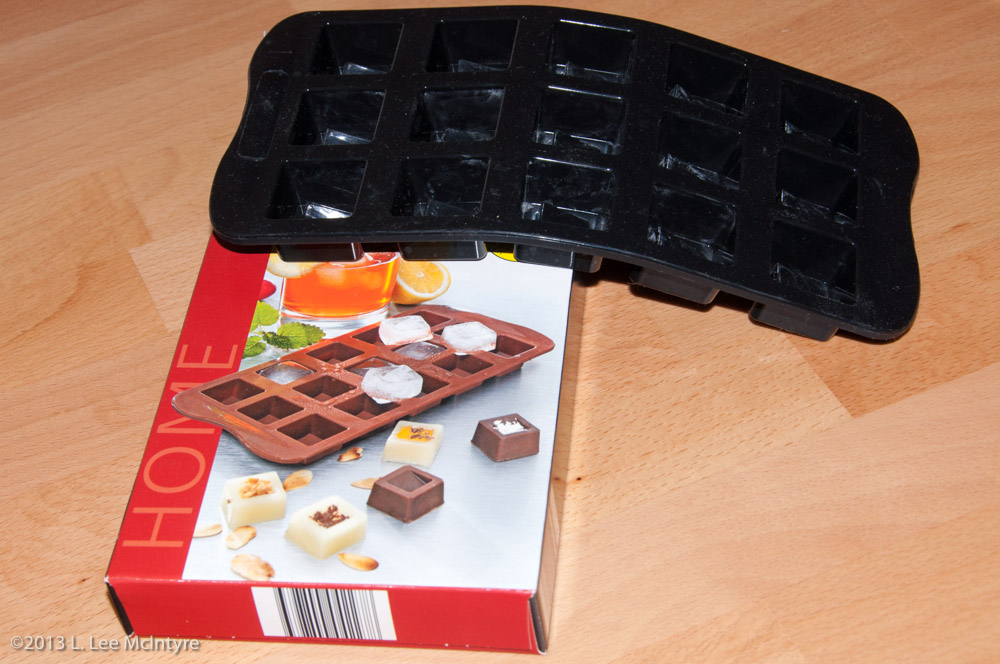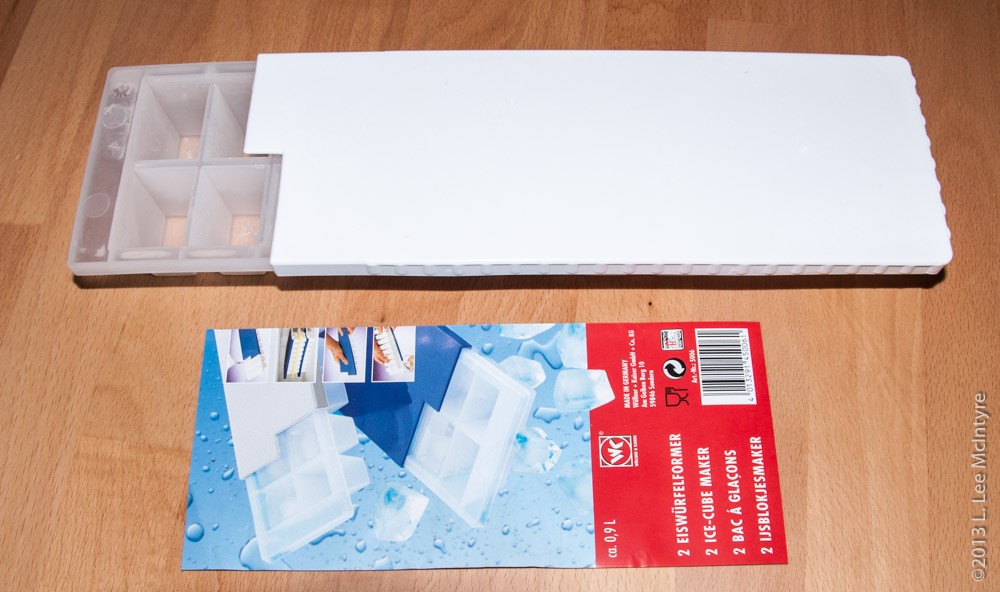Ice cubes are ubiquitous in drinks served in the U.S. One of the standard things you learn when you travel outside North America, however, is that ice-cubes are not all that commonly served.
Here in Germany, that’s true, although it seems to be changing a little, as American-style mixed drink “cocktails” are becoming more popular. But it’s still true that it’s not standard to find people making ice.
Which is why, I’m assuming, it’s not easy to find ice-cube trays here in Tübingen.
Recently, we wanted to make a rum and coke. This is not something we typically drink, but a friend had been to Cuba, and she gave us a bottle of rum that she’d brought back.
So, one day a month or so ago, when it was unexpectedly warm for a day, Chris and I thought we’d make a rum and coke to try the rum, as that was the easiest rum-based beverage we could think of to make. We had some chilled coke, and added some room-temperature rum. It was OK, but somehow it needed some ice in it to cool the rum off.
So, the challenge was to find ice-cube trays. We actually have a fancy refrigerator with a full-size freezer compartment. It was one of the kitchen appliances that was provided with our full-furnished kitchen in our otherwise unfurnished apartment. The refrigerator came with a plastic tray for eggs: hard or soft-boiled eggs are staples in a typical Germany breakfast, so I guess everybody needs one of those.
However, there were no ice-cube trays provided – as I said, people don’t make ice cubes very much around here.
Anyway, in order for us to make some ice, I set off to go to the local dollar-store like place to look for some inexpensive ice-cube trays.
Nothing.
Next, I checked my regular grocery store’s housewares aisle, which has lots of different kinds of kitchen gadgets. Including egg trays.
Nothing.
I wound up looking all over town before I stumbled on a lone fancy ice-cube tray made of a soft molded silicon in a grocery store I go to only occasionally. Now, I’ve seen muffin trays, cookie molds, and other baking pans made of this material, so I know it’s quite trendy, but I’ve never bought anything made out it before. At a cost of $4.5 dollars, it was certainly the most expensive ice-cube tray I could imagine. But it was the only one I’d found in more than a week of looking, so I bought it.
One thing that’s notable is that it is designed to make tiny, tiny ice cubes. Not ideal for drinks, IMHO. But the major drawback to the design — which is by a German company, BTW — indicates to me that folks in these parts clearly have no real experience with what goes on with making ice. This tray is made of a soft, flexible material, which is great for twisting to get the ice cubes to pop out after the ice is formed. But in order to make the ice, you must fill the cube squares with water, and then carry it over to the freezer.
Please take a moment to envision what happens when you pick up this soft, twisty, flexible tray and attempt to carry it and its water contents over to the freezer without spilling it.
Let’s just say it’s a highly efficient way to get water on the floor. It’s really very good for that.
I did manage to get some half-size cubes made by putting just a little bit of water in each cube section and not spilling too much on the way to the freeze. I just don’t understand how this concept is ever supposed to work without a support tray sitting underneath it to keep it steady as you move it into the refrigerator. But the box doesn’t picture that as even a suggestion.
Anyway, I went back on the hunt for a different ice-cube tray. Having exhausted my cheap-store options in the center of town, I then inquired about my options at a fancy housewares store. They had exactly one ice-cube tray system on offer:
This two-pack had to be the fanciest thing I’ve ever seen for making ice cubes: it’s got a hard plastic tray for the cubes, with each tray equipped with its own lid that slides up and down along the top to hold the water in place until the ice is frozen. It was even more expensive that the silicon tray, but at least it came two to a pack.
But again, a slight flaw in the design indicated a real lack of understanding as to what will happen when the tray is used to freeze water under the lid. You slid the lid down, fill the tray compartments with water, and then slide the lid back along the top. With the lid covered, it’s easy to carry over to the freezer to make the water in the tray turn to ice. So far, so good.
However, there is no way to keep the lid dry as you’re sliding it across the top of the water-filled compartments. So, when the water in the ice-cube compartments has frozen, so, too, has the water clinging to the lid. In other words, the top freezes shut. It’s impossible to slide the lid back to reveal the ice cubes underneath before the ice has melted.
I know what you’re thinking. Just don’t put the lid on the tray, right? After all, regular simpler ice-cube trays don’t usually have lids.
But now we come to a flaw I hadn’t really thought of with our fancy freezer. It has nice deep drawers to put things in, rather than shelves to put things on. Drawers are a nice feature in general in the freezer – the frozen vegetables I store in there are neatly organized, and the drawers pull out and down to allow access all the way to the back of the drawer.
But needing to pull the drawers out and down to get things in and out is not a good thing when it comes to introducing an uncovered tray of water into the drawer. All the movement required when the drawers go in and out efficiently spills water out of the tray as it shakes along with the drawer. Which is great if you want to get water all over the drawer — which could be seen as helpful for cleaning, perhaps — but it’s not great for making ice, since there’s little water left in the tray when the drawer is pushed back into place.
See, the lids on those trays would actually be quite a good design, if only they didn’t freeze onto the trays once the ice is formed.
Who ever dreamed that making ice could be so complicated.
It’s something to ponder while sipping a room-temperature rum and coke.



can you find cup cake papers, some come in foil, put them on or in a plastic container, put in the freezer, and add the water while in the freezer so u don’t carry any water filled item to the freezer. What’s wrong with putting water into an egg tray and freezing it that way.
sorry, I should have been clearer about the egg tray – it has no bottom, just the opening in a frame for the eggs. So, no, won’t work as a form for the cubes. 😉 Adding the water when the tray is in the drawer also was something I tried, but the necessary tilt of the drawer when you pull it out means that it has to tilt back up push it in – and the water comes splashing out when there’s no lid on the tray. Odd design for a freezer only if you’re trying to make ice cubes. 😉